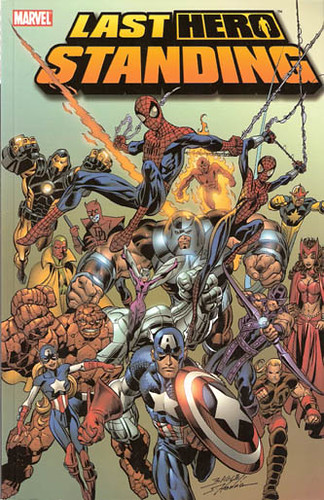Last Hero Standing
Collects: Last Hero Standing #1-5 (2005)
Released: September 2005 (Marvel)
Format: 120 pages / color / $13.99 / ISBN: 9780785118237
What is this?: The heroes of the future Marvel Universe face a dark threat as their cohorts are kidnapped.
The culprits: Writer Tom DeFalco and artist Pat Olliffe
Now in Canceled Alternate Future Theater, we have Last Hero Standing. Do you care whether future versions of Marvel heroes live or die? Do you even know who the featured, younger heroes in this book are? I’m going to guess the answer to both is “No” and proceed from there.
At a couple of points early in the MC2 Universe’s existence, it had three titles, but within a year and a half of the imprint’s founding in 1998, it had been pared down to one title: Spider-Girl. This left several loose ends, with both new characters and familiar Marvel Universe characters still running around. To capitalize on this, Marvel released Last Hero Standing.
 In Hero, superheroes begin disappearing — Wolverine, Spider-Man, the Thing, one of the Ladyhawks — and the other heroes blindly investigate. As more are abducted and the remaining heroes come closer to finding the truth, the missing heroes return as ‘90s version of themselves, albeit without pouches, spikes, or shoulder pads. No, they’re grittier and grimmer, and they are out for the blood of those they loosely define as villains. Meanwhile, the aged Captain America wrestles with failing abilities in an environment in which small failures could lead to death — his or another’s.
In Hero, superheroes begin disappearing — Wolverine, Spider-Man, the Thing, one of the Ladyhawks — and the other heroes blindly investigate. As more are abducted and the remaining heroes come closer to finding the truth, the missing heroes return as ‘90s version of themselves, albeit without pouches, spikes, or shoulder pads. No, they’re grittier and grimmer, and they are out for the blood of those they loosely define as villains. Meanwhile, the aged Captain America wrestles with failing abilities in an environment in which small failures could lead to death — his or another’s.
There’s not much to say about Hero, good or ill. It’s most of a universe folded into a single limited series, much in the *ahem* proud tradition of 2099: World of Tomorrow. Cramming umpteen heroes into one story means plot will likely be more important than characterizations. True, the Avengers and Spider-Girl display differentiated personalities, but none of them make an impression.
And the plot is not one of writer Tom DeFalco’s stronger MC2 efforts. The abduction, mind control, and last-second saving the day aren’t anything new. The ending will hinge on whether you get choked up by the fate of alternate future versions of familiar characters. DeFalco leans more on Marvel heroes readers are more familiar with than he did in the A-Next run, but the jarring effect of the normally heroic characters becoming vicious is cushioned by the passage of years between the 616 Universe and MC2 — we don’t know what happened during those years.
Pat Olliffe does his usual good work on an MC2 title. Interestingly, this is one of the few times I’ve gotten to see his work in a full-size reproduction rather than a digest, and I’m surprised how much the smaller size and cheaper paper seems to harm his work. Seeing Olliffe in a normal size makes me realize the digests might not be as big a bargain as I thought. It still won’t stop me from buying future digests, but this does alert me as to what I’m missing.
Still, I have to say this is an underwhelming book. If you want to know more about the history of the MC2 Universe, you read Hero. If not, go elsewhere. It’s as simple as that.
Rating: ![]()
![]() (2 of 5)
(2 of 5)
Labels: 2, Marvel, MC2, Pat Olliffe, Spider-Girl, Tom DeFalco




0 Comments:
Post a Comment
<< Home